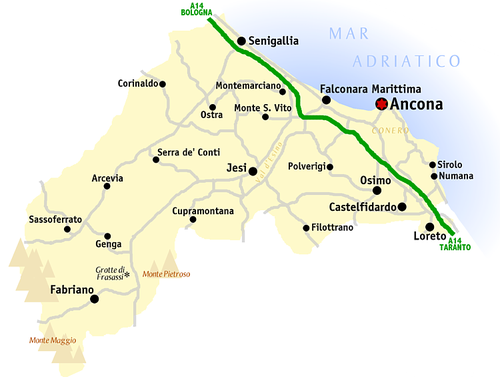Ancona Province is in Marche Region in Italy. Its coastline of sandy beaches is popular with Italians but has not been greatly affected by tourism. Annually, feasts occur in the province during the harvesting period. It has mountainous regions and the Conero Regional Park, which have dense forests where black truffles are found.
Cities
[edit]- 1 Ancona — a major port on the Adriatic Sea
- 2 Fabriano — a city under the Ancona district, famous for its paper production story since the 13th century
- 3 Jesi — a walled city famous for its Verdicchio wine
- 4 Montemarciano — the church of San Pietro Apostolo is example of 18th century Roman architecture
- 5 Senigallia — a home of Michelin-starred restaurant Uliassi
Other destinations
[edit]- 1 Frasassi Caves — a karst cave system open to public, among the most famous show caves in Italy
Understand
[edit]Ancona coast
[edit]
The capital Ancona and nearby Falconara Marittima are located in a bend of the Adriatic Sea.
To the south of the capital is the promontory of Monte Conero, established as a regional park in 1991, and the Conero Riviera with the seaside resorts of Portonovo, Numana and the beaches of Sirolo is a popular summer holiday destination.
Further south, on a hill with a panoramic view of the sea, stands Loreto with the Basilica of the Holy House, one of the most venerated places of Catholic pilgrimage.
To the north of Ancona is Senigallia, a city of pre-Roman origins with a tourist port and a considerable artistic heritage.
Interior
[edit]- Esino Valley — In the Esino Valley, the most important river in the Marche in terms of basin area, are Chiaravalle , with the Abbey of Santa Maria in Castagnola, an interesting example of Cistercian architecture, Jesi, the production area of the "Verdicchio dei Castelli di Jesi" wine, and Serra San Quirico, surrounded by medieval walls. The small town of Arcevia with its castles and prehistoric sites can be reached via a branch road from Serra San Quirico. Continuing up the Esino River, you come across Fabriano , renowned for its paper mills and its historic centre as well as for excursions to the nearby mountains of the Umbrian-Marche Apennines.
- Cesano Valley — The Cesano is a small river that has its sources in Mount Catria in the territory of Urbino and flows into the Adriatic near Senigallia. The most interesting center of the valley is Corinaldo, long included in the list of "the most beautiful villages in Italy" and also known for the witches' festival at the end of October, which is worthy of the backdrop of the alleys of the town and its ancient houses.
- Osimo — Close to Loreto, Osimo is a city with interesting architecture and, in addition, its subsoil has a network of caves that communicate with the cellars of ancient noble palaces.
Get in
[edit]By train
[edit]Ancona is primarily served by two main railway lines:
- Along the coast, it is crossed by the Bologna-Ancona Line and, heading toward Lecce, by the Adriatic line.
- Transversally, it is served by the Trans-Apennine Line connecting Ancona, Foligno, Orte, and Rome, with Ancona Centrale station as its terminal hub.
There are also other regional railway lines of interest, such as the Civitanova Marche–Fabriano line and the Pergola–Fabriano line.
By plane
[edit]Marche Airport (AOI IATA; Ancona Falconara Airport) is the only airport with scheduled passenger flights in the province.
Get around
[edit]See
[edit]Do
[edit]Eat
[edit]The province, particularly in the inland areas, has maintained a strong connection to traditional rural life. The efforts of various municipalities, organisations, associations, and agricultural entrepreneurs have enabled the preservation and promotion of a wide range of high-quality traditional products. These include niche specialities such as the Suasa Onion and some internationally renowned products like Verdicchio wine.
Drink
[edit]Verdicchio dei Castelli di Jesi is a famous white wines that goes particularly well with fish and should be served chilled.
A large area of the province's land is farmland used for wine production; the province produces wines using the Montepulciano, Sangiovese, and Verdicchio varieties of grape.
Stay safe
[edit]Go next
[edit]

